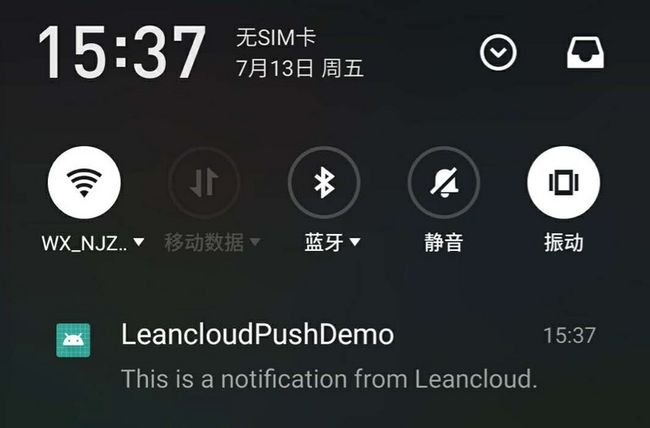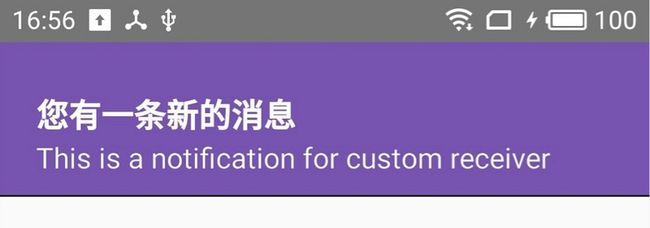前言
在上一篇文章 中我们详细讲解了用Leancloud实现iOS消息推送的流程,今天本文将继续讲解实现Android的消息推送。
接入Leancloud
在接入Leancloud之前,还是推荐先阅读Leancloud官方的 Android消息推送开发指南。
安装Leancloud SDK
SDK有多种安装方式,详情请参考Android SDK安装指南。我选择用Gradle安装,先在根目录下的build.gradle中添加Leancloud的maven仓库地址:
buildscript {
repositories {
jcenter()
maven {
url 'https://maven.google.com/'
name 'Google'
}
maven {
url "http://mvn.leancloud.cn/nexus/content/repositories/public"
}
}
dependencies {
classpath 'com.android.tools.build:gradle:2.3.3'
}
}
allprojects {
repositories {
mavenLocal()
jcenter()
maven {
url "$rootDir/../node_modules/react-native/android"
}
maven {
url 'https://maven.google.com/'
name 'Google'
}
maven {
url "http://mvn.leancloud.cn/nexus/content/repositories/public"
}
}
}
然后打开 app 目录下的 build.gradle 进行如下配置:
android {
//为了解决部分第三方库重复打包了META-INF的问题
packagingOptions{
exclude 'META-INF/LICENSE.txt'
exclude 'META-INF/NOTICE.txt'
}
lintOptions {
abortOnError false
}
...
}
...
dependencies {
...
// LeanCloud 基础包
compile ('cn.leancloud.android:avoscloud-sdk:v4.6.4')
// 推送与实时聊天需要的包
compile ('cn.leancloud.android:avoscloud-push:v4.6.4@aar'){transitive = true}
}
初始化Leancloud
我们需要在App创建后用Leancloud的AppId,AppKey进行初始化,修改MainApplication如下:
@Override
public void onCreate() {
super.onCreate();
...
//初始化leancloud
AVOSCloud.initialize(this,"ppdriT1clcnRoda0okCPaB48-gzGzoHsz","Qzarq5cMdWzAMjwDW4umWpBL");
}接下来,在AndroidManifest.xml中配置Leancloud SDK所需的权限以及消息推送所需的service和receiver:
...
...
到此,Leancloud SDK的接入完成,我们需要测试一下SDK能不能正常使用。我们在MainActivity.java的onCreate方法中添加代码看能不能保存数据到Leancloud数据库:
@Override
protected void onCreate(Bundle savedInstanceState) {
...
// 测试 SDK 是否正常工作的代码
AVObject testObject = new AVObject("TestObject");
testObject.put("words","Hello World!");
testObject.saveInBackground(new SaveCallback() {
@Override
public void done(AVException e) {
if(e == null){
Log.d("saved","success!");
}
}
});
...
}启动App,前往Leancloud控制台,查看数据库中是否多了一条TestObject的记录,如果有说明Leancloud SDK接入成功:
保存Installation
和iOS一样,Android也需要保存installation才能让Leancloud确定推送到哪些设备。但是比较坑的是:Leancloud官方提供的 leancloud-installation只能正确保存iOS设备的installation。 因此我们只能使用Android的SDK保存installation,而且我们最好把这个方法封装成一个native模块暴露给js调用,以方便在保存成功或失败后执行相应操作。
在com.leancloudpushdemo文件夹中创建PushModule.java,PushDemo继承于ReactContextBaseJavaModule并实现ActivityEventListener接口,添加如下代码:
package com.leancloudpushdemo;
import android.app.Activity;
import android.content.Intent;
import com.avos.avoscloud.AVException;
import com.avos.avoscloud.AVInstallation;
import com.avos.avoscloud.SaveCallback;
import com.facebook.react.bridge.ActivityEventListener;
import com.facebook.react.bridge.Callback;
import com.facebook.react.bridge.ReactApplicationContext;
import com.facebook.react.bridge.ReactContextBaseJavaModule;
import com.facebook.react.bridge.ReactMethod;
public class PushModule extends ReactContextBaseJavaModule implements ActivityEventListener {
public PushModule(ReactApplicationContext reactContext) {
super(reactContext);
}
@Override
public String getName() {
return "androidPushModule";
}
@Override
public void onNewIntent(Intent intent) {}
@Override
public void onActivityResult(Activity activity, int requestCode, int resultCode, Intent data) {}
/**
* 保存installation
*/
@ReactMethod
public void saveInstaillation(final Callback resultCallback) {
AVInstallation.getCurrentInstallation().saveInBackground(new SaveCallback() {
public void done(AVException e) {
if (e == null) {
// 保存成功
String installationId = AVInstallation.getCurrentInstallation().getInstallationId();
resultCallback.invoke(installationId);
} else {
resultCallback.invoke();
}
}
});
}
}
接着在同一目录下面添加PushPackage.java用于注册PushModule模块,代码如下:
package com.leancloudpushdemo;
import com.facebook.react.ReactPackage;
import com.facebook.react.bridge.NativeModule;
import com.facebook.react.bridge.ReactApplicationContext;
import com.facebook.react.uimanager.ViewManager;
import java.util.ArrayList;
import java.util.Collections;
import java.util.List;
public class PushPackage implements ReactPackage {
@Override
public List createNativeModules(ReactApplicationContext reactContext) {
List modules = new ArrayList<>();
modules.add(new PushModule(reactContext));
return modules;
}
@Override
public List createViewManagers(ReactApplicationContext reactContext) {
return Collections.emptyList();
}
}
然后,在MainApplication.java中的getPackages方法中增加PushPackage:
@Override
protected List getPackages() {
return Arrays.asList(
...
new PushPackage()
);
} 接着,在我们的PushService.js中引入PushModule并保存installation:
...
import { NativeModules } from 'react-native';
const AndroidPush = NativeModules.androidPushModule;
...
class PushService {
...
//Android
_an_initPush = () => {
this._an_saveInstallation();
}
_an_saveInstallation = () => {
AndroidPush.saveInstaillation((installationId) => {
if (installationId) {
console.log('Android installation 保存成功!');
}
})
}
...
}最后,在App.js中执行Android的初始化:
componentDidMount() {
if (Platform.OS === 'ios') {
PushService._iOS_initPush();
} else {
PushService._an_initPush();
}
MessageBarManager.registerMessageBar(this.refs.alert);
}重启App,前往Leancloud控制台中查看数据库中是否多了一条installation记录,如果有说明保存成功:
如果确认代码没问题,但是还是保存不成功,我建议:
- 重启Android Studio
- 重启React Native Packager
- 重启电脑、手机。。
- 如果还有问题,欢迎咨询我
实现系统推送
启动推送服务
首先调用Leancloud SDK启动推送服务:
PushService.setDefaultPushCallback(getReactApplicationContext(), PushHandlerActivity.class);PushHandlerActivity为收到通知默认打开的activity,我们接下来实现。
PushHandlerActivity实现
该activity的定位为接收并初步解析通知数据。我们在com.leancloudpushdemo文件夹下添加PushHandlerActivity.java,内容如下:
package com.leancloudpushdemo;
import android.app.Activity;
import android.content.Intent;
import android.content.pm.PackageManager;
import android.os.Bundle;
import java.util.HashMap;
import java.util.Map;
public class PushHandlerActivity extends Activity {
@Override
protected void onCreate(Bundle savedInstanceState) {
super.onCreate(savedInstanceState);
processPush();
finish();
if (!PushModule.isActive()) { //todo:判断PushModule是否实例化
relaunchActivity();
}
}
private void processPush() {
try {
Intent intent = getIntent();
String action = intent.getAction();
String channel = intent.getExtras().getString("com.avos.avoscloud.Channel");
String data = intent.getExtras().getString("com.avos.avoscloud.Data");
Map map = new HashMap();
map.put("action", action);
map.put("channel", channel);
map.put("data", data);
PushModule.onReceive(map); //todo:处理通知
} catch (Exception e) {
PushModule.onError(e); // todo:处理错误
}
}
private void relaunchActivity() {
PackageManager pm = getPackageManager();
Intent launchIntent = pm.getLaunchIntentForPackage(getApplicationContext().getPackageName());
startActivity(launchIntent);
}
}
别忘了在AndroidManifest.xml中加上该activity:
主要处理逻辑实现
PushHandlerActivity代码中有三处todo是我们接下来要在PushModule中实现的逻辑。关于接收到通知后如何处理,我的思路是当native module收到通知时,通过RCTDeviceEventEmitter触发相应的Event,在js中监听这些Event并响应,修改PushModule如下:
public class PushModule extends ReactContextBaseJavaModule implements ActivityEventListener {
private static PushModule singleton;
private static String ON_RECEIVE = "leancloudPushOnReceive";
private static String ON_ERROR = "leancloudPushOnError";
public PushModule(ReactApplicationContext reactContext) {
super(reactContext);
singleton = this;
}
...
protected static boolean isActive() {
return singleton != null;
}
private static WritableMap getWritableMap(Map map) {
WritableMap writableMap = Arguments.createMap();
writableMap.putString("action", map.get("action"));
writableMap.putString("channel", map.get("channel"));
writableMap.putString("data", map.get("data"));
return writableMap;
}
protected static void onReceive(Map map) {
if (singleton != null) {
WritableMap pushNotification = getWritableMap(map);
DeviceEventManagerModule.RCTDeviceEventEmitter emitter = singleton.getReactApplicationContext().getJSModule(DeviceEventManagerModule.RCTDeviceEventEmitter.class);
emitter.emit(ON_RECEIVE, pushNotification);
}
}
protected static void onError(Exception e) {
if (singleton != null) {
WritableMap error = Arguments.createMap();
error.putString("message", e.getLocalizedMessage());
DeviceEventManagerModule.RCTDeviceEventEmitter emitter = singleton.getReactApplicationContext().getJSModule(DeviceEventManagerModule.RCTDeviceEventEmitter.class);
emitter.emit(ON_ERROR, error);
}
}
@Override
public Map getConstants() {
final Map constants = new HashMap<>();
constants.put("ON_RECEIVE", ON_RECEIVE);
constants.put("ON_ERROR", ON_ERROR);
return constants;
}
... 最后,我们在PushService.js增加对消息通知相关事件的监听和处理的逻辑,我选择在保存installation成功后增加监听:
...
import { DeviceEventEmitter } from 'react-native';
...
class PushService {
...
_an_saveInstallation = () => {
AndroidPush.saveInstaillation((installationId, error) => {
if (installationId) {
DeviceEventEmitter.addListener(AndroidPush.ON_RECEIVE, (notification) => {
console.log('receive android notification');
this._an_onNotificationTapped(notification);
});
DeviceEventEmitter.addListener(AndroidPush.ON_ERROR, (res) => {
console.log('android notification error');
console.log(res);
});
} else {
console.log(error);
}
})
}
_an_onNotificationTapped = (notification) => {
Alert.alert('Android Notification Tapped');
}
}
...现在我们在Leancloud控制台发送一条通知,手机应该能收到消息:
当点击通知的时候,App打开并执行我们自定义的逻辑:
实现App打开状态下的推送
到目前为止,我们已经实现了系统级的推送,和iOS一样,我们希望Android App打开状态下也能弹出通知提醒。Leancloud提供了这样的可能,我们可以通过 自定义Receiver 来实现。
自定义Receiver
我们在com.leancloudpushdemo路径下添加CustomPushReceiver.java,代码如下:
package com.leancloudpushdemo;
import android.content.BroadcastReceiver;
import android.content.Context;
import android.content.Intent;
import com.alibaba.fastjson.JSON;
import com.alibaba.fastjson.JSONException;
import com.alibaba.fastjson.JSONObject;
import java.util.HashMap;
import java.util.Map;
public class CustomPushReceiver extends BroadcastReceiver {
private static final String TAG = "CustomPushReceiver";
private HandleMessage handleMessage;
@Override
public void onReceive(Context context, Intent intent) {
try {
String action = intent.getAction();
String channel = intent.getExtras().getString("com.avos.avoscloud.Channel");
//获取消息内容
String data = intent.getExtras().getString("com.avos.avoscloud.Data");
JSONObject jsonObject = JSON.parseObject(data);
if (jsonObject != null) {
Map map = new HashMap();
map.put("action", action);
map.put("channel", channel);
map.put("data", data);
PushModule.onCustomReceive(map); //todo: 处理通知
if (handleMessage!=null){
handleMessage.receiveMessage(jsonObject);
}
}
} catch (JSONException e) {
PushModule.onError(e);
}
}
interface HandleMessage{
public void receiveMessage(JSONObject jsonObject);
}
public void setHandleMessage(HandleMessage handleMessage) {
this.handleMessage = handleMessage;
}
} todo的方法待会儿在PushModule中实现。接着,在AndroidManifest.xml中添加custom receiver:
通知处理
然后修改PushModule如下:
public class PushModule extends ReactContextBaseJavaModule implements ActivityEventListener {
...
private static String ON_CUSTOM_RECEIVE = "leancloudPushOnCustomReceive";
...
protected static void onCustomReceive(Map map) {
if (singleton != null) {
WritableMap pushNotification = getWritableMap(map);
DeviceEventManagerModule.RCTDeviceEventEmitter emitter = singleton.getReactApplicationContext().getJSModule(DeviceEventManagerModule.RCTDeviceEventEmitter.class);
emitter.emit(ON_CUSTOM_RECEIVE, pushNotification);
}
}
...
@Override
public Map getConstants() {
final Map constants = new HashMap<>();
constants.put("ON_RECEIVE", ON_RECEIVE);
constants.put("ON_CUSTOM_RECEIVE", ON_CUSTOM_RECEIVE);
constants.put("ON_ERROR", ON_ERROR);
return constants;
}
} 最后,修改PushService.js,增加对ON_CUSTOM_RECEIVE事件的监听:
...
_an_saveInstallation = () => {
AndroidPush.saveInstaillation((installationId, error) => {
if (installationId) {
...
DeviceEventEmitter.addListener(AndroidPush.ON_CUSTOM_RECEIVE, (notification) => {
console.log('receive custom android notification');
this._showAlert(JSON.parse(notification.data).alert);
});
...
} else {
...
}
})
}
...同时通知的消息提也需要做相应修改,才能让custom receiver接收到,我们可以用Postman来发送消息:
消息发出后,App中成功弹出消息提醒,完美。
结语
经过不懈的努力,我们已经成功使用Leancloud实现了iOS和Android上的消息通知,第一次写这么长的文章还是有点累的。。如果对你有帮助欢迎点赞!还有虽然功能都实现了,但是我想可能还会有更好的实现方式,欢迎找到的同学分享,谢谢!
相关链接
iOS篇地址:使用Leancloud实现React Native App的消息推送(Push Notification)- iOS篇
本文Demo Github地址:https://github.com/MudOnTire/LeancloudPushDemo)





